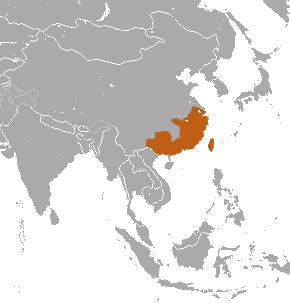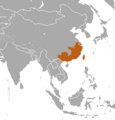Chinese hare facts for kids
Quick facts for kids Chinese hare |
|
|---|---|
 |
|
| Conservation status | |
| Scientific classification | |
| Genus: |
Lepus
|
| Species: |
sinensis
|
 |
|
| Chinese hare range | |
The Chinese hare (Lepus sinensis) is a type of mammal that belongs to the rabbit and hare family, Leporidae. You can find these hares in China, Taiwan, and a small part of Vietnam. They are known for their speed and their unique way of getting all the nutrients from their food.
Contents
What is a Chinese Hare?
The Chinese hare is a small animal. It usually grows to be about 40 to 76 centimeters (16 to 30 inches) long. Females are a bit larger than males. They weigh around 1.25 to 1.94 kilograms (2.75 to 4.28 pounds).
How to Spot a Chinese Hare
Chinese hares have short, rough fur. Their back and chest are a chestnut-brown color. Their belly is whitish. They have large hind feet covered in fur. Their tail is brown, and the tips of their ears have black patches shaped like triangles. You can tell them apart from other hare species by looking closely at their skull and teeth.
Where Do Chinese Hares Live?
Chinese hares live in many parts of China. These include the provinces of Anhui, Fujian, Guangdong, Guangxi, Guizhou, Hunan, Jiangsu, Jiangxi, and Zhejiang. They also live on the island of Taiwan. You can find a small group of them in north-eastern Vietnam too.
What is Their Home Like?
Unlike rabbits, Chinese hares do not live in underground burrows. Instead, they make a simple nest called a "form." This nest is usually found in tall grass or other thick plants. It helps them hide from predators.
How Do Chinese Hares Live?
Scientists haven't studied Chinese hares as much as other animals. But we know some interesting things about them.
What Do They Eat?
Like other hares, the Chinese hare eats mostly plants. Their diet includes grasses, green plant material, buds, small twigs, and tree bark. They are mostly active at night, which means they are nocturnal.
A Special Way to Eat
Chinese hares produce two kinds of droppings: moist and dry pellets. They eat the moist pellets right away. This might sound strange, but it's a clever way to get all the good nutrients from their food. It helps them digest their food twice!
Baby Hares
When baby hares are born, they are called "precocial." This means they are born quite developed. They have fur, can see, and can move around soon after birth. A mother hare usually gives birth to about three young in her nest. She visits them only once a day for a few minutes to let them drink her milk. Her milk is very rich in protein and fat. The babies drink milk for about three weeks.
Staying Safe
Many animals hunt Chinese hares, such as carnivores (meat-eating animals). To escape from these predators, Chinese hares rely on their amazing speed. They can run very fast to get away from danger.
Are Chinese Hares in Danger?
The IUCN (International Union for Conservation of Nature) keeps a list of animals and their risk of disappearing. They have listed the Chinese hare as "Least Concern." This means they are not currently in danger because they live in a wide area.
However, in Vietnam, Chinese hares live in places where many people also live. This puts them at risk from hunting. In China, we don't know if their numbers are going up or down. More research is needed to understand their population trends.
Taxonomy: How They Are Classified
The Chinese hare was first described by a scientist named John Edward Gray in 1832. For a while, the Korean hare was thought to be a type of Chinese hare. But later studies looked at their DNA (the genetic material that makes each animal unique). These studies showed that the Korean hare is actually its own separate species.
Images for kids




